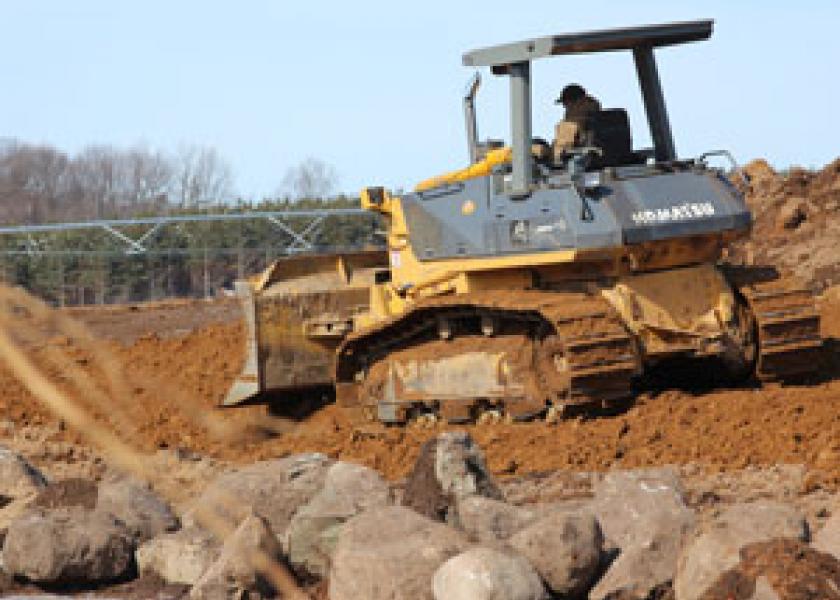Drought Proves that in Farming, Resilience Reigns

Farmers are rushing to be better prepared for a possible drought Round Two. Michigan farmer Dick Dobbins, Jr. is installing seven new pivots this year alone.
"We design our irrigation systems, because of the cost of the wells, we try to service as many pivots as we can out of one well," Dobbins says.
He says each well costs anywhere from $30,000 to $40,000. With pivot prices so steep, many farmers have been reluctant to make the investment. After the record drought and near-record farm incomes last year, attitudes and business decisions have changed.
Laying the groundwork for new pivots has been a commons sight across the country this winter. Both Lindsay Corporation and Valmont Industries reordered strong irrigation sales last year. Lindsay’s total irrigation equipment sales jumped 33% in just the first quarter of this fiscal year. With such rapid growth, some irrigation companies are on pace to hit records. Sales are popping up in more than just the Western Corn Belt. A Lindsay spokesperson told AgDay they’re also seeing growth in non-typical areas like the Eastern Corn Belt and in Southern states, like Tennessee and Kentucky.
Meanwhile, U.S. farmers have a tall order this year. National Corn Growers Association CEO Rick Tolman says global demand for U.S. corn puts pressure on America’s farmers to grow a big crop.
"We’ve lost about half of our exports this year, because of the drought," Tolman says. "We knew the market would have to adjust some, but it turns out the hardest hit has been exports. We’re about half of where we normally are with exports.
He says countries like Brazil and Argentina are gladly filling that void. This could create a tough situation for the U.S. over the next few years in rebuilding the United States’ competitive export advantage.
"We need to get enough corn so we can supply those needs. Then we're going to have to go back to those countries and point out to them we've been a long term supplier," Tolman says. "We had a once-in-50-year drought. We don't expect that to happen again. In fact, we think we'll be out producing the market really quickly."
The likelihood of another widespread drought this year is waning, but predictions are still mixed. University of Missouri climatologist Tony Lupo says the good news is a La Niña has left the picture. The bad news is his long-term forecast is a tad on the dry side.
"Drought is a long-term prospect," Lupo says. "You get into it really slow and it takes a while to get back out of it. We really need above normal precipitation to help us get out of that."
Meanwhile, National Oceanic and Atmospheric Administration (NOAA) just released its U.S. Season Drought Outlook. It doesn’t look promising for states like California, Colorado, New Mexico and California, as it shows the drought will persist or even intensify. It shows some improvement in Kansas and Nebraska.
All farmers want right now is a normal year. University of Missouri Food and Agricultural Policy Research Institute (FAPRI) economist Pat Westhoff says a normal year could be good news for livestock producers.
"For the crop we harvest next fall, if we get more normal yields in 2013, we could be talking about a price $5 or less," Westhoff says. "That would mean lower cost to ethanol producers lower cost to livestock producers, lower cost to foreign purchases of U.S. Product"
With the latest picture of the drought still painted mostly red in the Western Plains, the chances of turning things around this year seems grim. Oklahoma State University Livestock Specialist Derrell Peel says this creates questions on the livestock outlook.
"I think it's very much up in the air to whether this is a year of herd building or a liquidation year," Peel says. "I think under the best of circumstances, it's a restabilizing year. But it's very much up in the air whether that happens."
He says while a few winter storms left moisture, states like Oklahoma desperately need more. That’s threatening the future of many producers’ already smaller herds.
"Every year we push off this beginning of rebuilding, is going to be an even deeper hole and take us even deeper and longer just for biological reasons, the limited supply of cattle will push it out even further," Peel says.
While the drought continues to weigh on the minds of farmers like Dobbins, it’s rebuilding and recuperating after such a trying year that proves in farming, resilience reigns.







